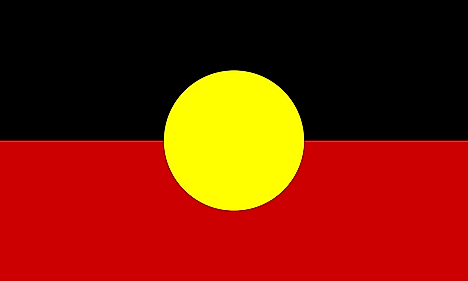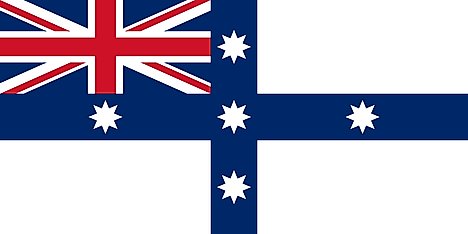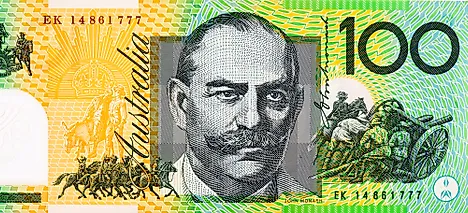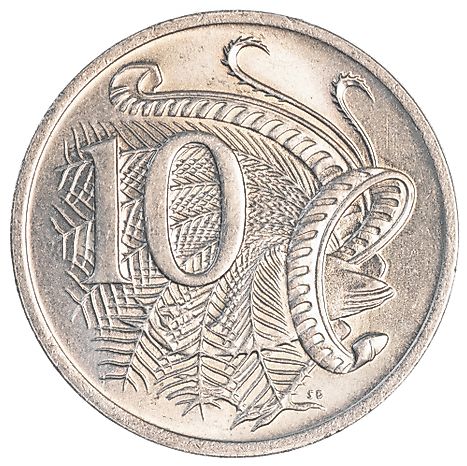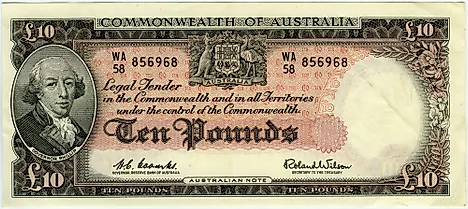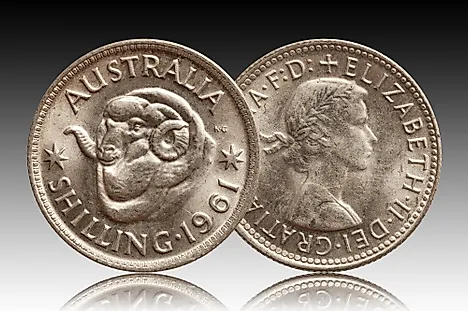Flags, Symbols & Currency of Australia
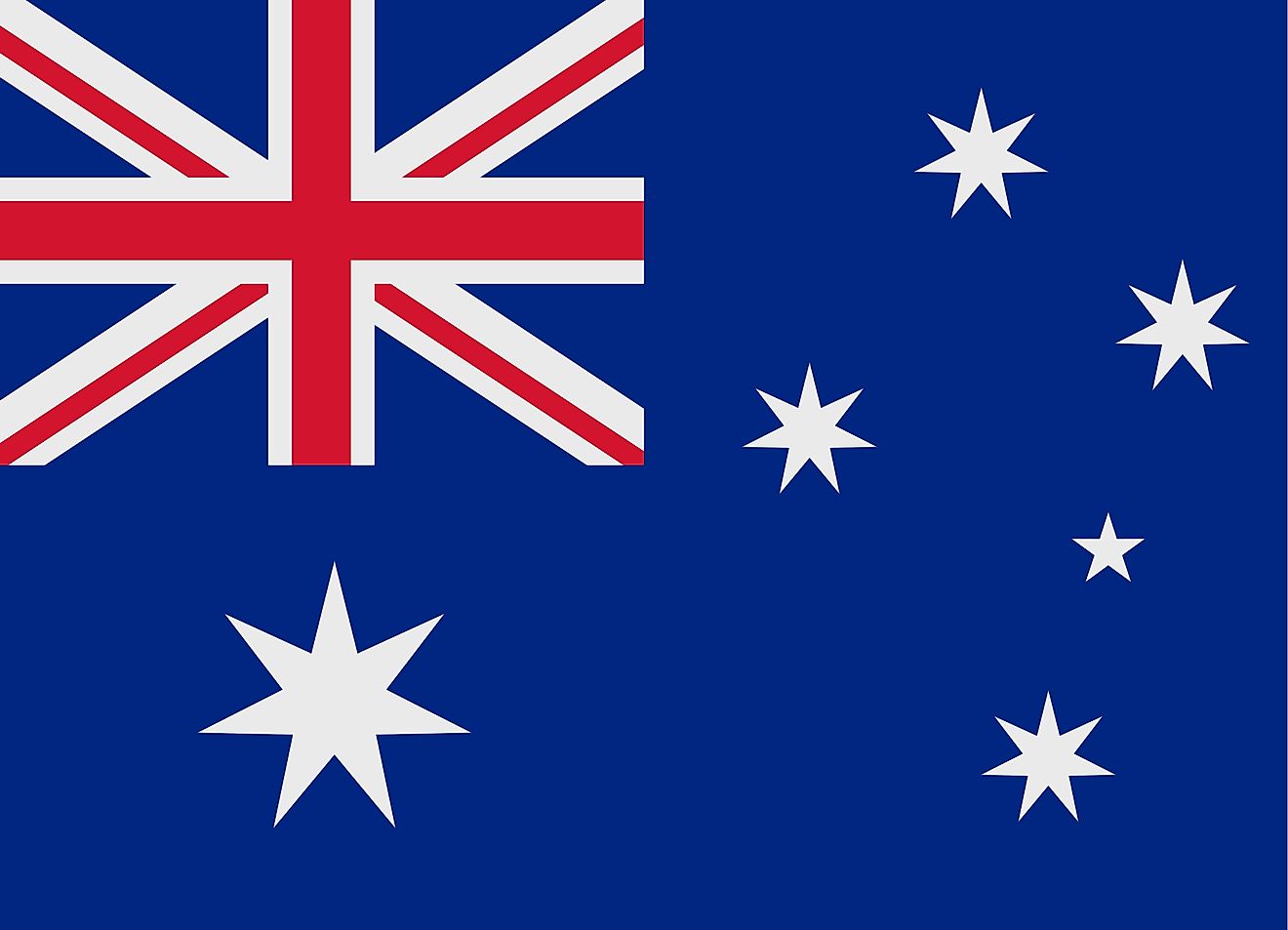
The Australian Flag was first flown on 3rd September 1901. Entries were invited to compete in the flag design of the country. A design was passed in 1903 by King Edward VII; while the modern 7-pointed Commonwealth Star version was adopted on 8th December 1908. Its dimensions were officially gazetted in 1934 and The Flags Act of 1953 gave the flag the official status of "Australian National Flag”; which was recognized and officially approved by the British sovereign on 14th February 1954.
Australia's national flag consists of a dark blue field and features three primary components namely the Commonwealth Star, the Southern Cross, and the Union Jack. In the upper left corner (hoist-side quadrant), the Union Jack represents Australia's association with Great Britain (UK). Directly below the Union Jack in the lower hoist-side quadrant is a large seven-pointed star known as the white Commonwealth or Federation star. The star depicts one point for each of the six original states of Australia in 1901; and the seventh point, added to the stars in 1909, denotes all the internal and external territories of the Commonwealth of Australia. On the fly-half is a representation of the Southern Cross constellation in white with one small five-pointed star and four larger, seven-pointed stars. The stars are a reminder of Australia's geographical location, as this constellation can only be seen from the southern hemisphere. The flag has a height to length proportion ratio of 1:2.
History of the Australian Flag
In 1901, the first Prime Minister of Australia – the Rt Hon Sir Edmund Barton, announced an international competition to design a flag for the new Commonwealth of Australia. The flag was flown for the first time on 3rd September 1901 at the Exhibition Building in Melbourne. In 1903 King Edward VII approved two designs for the flag of Australia: The Commonwealth blue ensign and the Commonwealth red ensign for the Merchant Navy. The Flags Act 1953 subsequently proclaimed the Australian blue ensign as the Australian National Flag and the Australian red ensign as the flag for merchant ships registered in Australia. Australia also has several other official flags including the Australian Aboriginal Flag, the Torres Strait Islander Flag, and the ensigns of the Australian Defence Force.
Symbols of Australia
National Coat of Arms of Australia
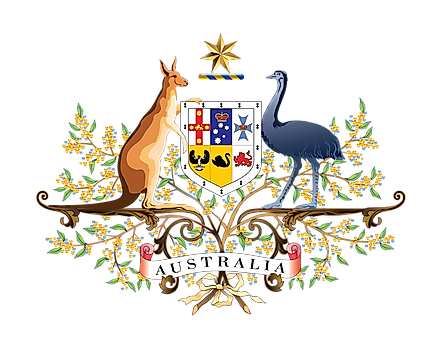
The Commonwealth Coat of Arms is the formal symbol of the Commonwealth of Australia and was officially adopted on September 19, 1912 as granted by King George V. It consists of a shield portraying the badges of the six Australian states, enclosed by an ermine border. The three states on the top half (from left to right) are New South Wales, Victoria, and Queensland. The bottom half (from left to right) are South Australia, Western Australia, and Tasmania. The border of the shield symbolizes the federation of the states, which took place in 1901. The shield supporting the Coat of Arms is held up by the native Australian animals - the red kangaroo and the emu. It symbolizes a nation’s progress and an unwillingness to back down, based on the fact that neither animal can walk backwards. Above the shield is the crest, a seven-pointed gold Commonwealth Star on a blue and gold wreath. Six of the star’s points are representative of the states of the Commonwealth and the seventh point represents the territories of Australia. Gold and blue are the Commonwealth Coat of Arm’s identifying colors. The background contains a wreath of golden wattle (Acacia pycnantha) - the official national floral emblem of Australia. At the bottom of the Coat of Arms is a scroll containing the name ‘Australia’.
National Animal of Australia - Kangaroo

The red kangaroo (Macropus rufus) is the national animal of Australia. It is the largest terrestrial mammal endemic to Australia and is found all across the mainland. It is known for its excellent ability to adapt to the harsh environments prevailing across large parts of Australia. Due to its stable populations and widespread distribution, it is a "Least Concern" species on the IUCN Red List. Red kangaroos have front limbs with small claws and two muscular and robust hind-limbs that are mainly used for jumping. They also have a strong tail which is used for support when standing in an upright position and balance while leaping. In a typical leap, the male kangaroo can cover 8-9m while reaching heights of 1.8-3m.
National Bird of Australia
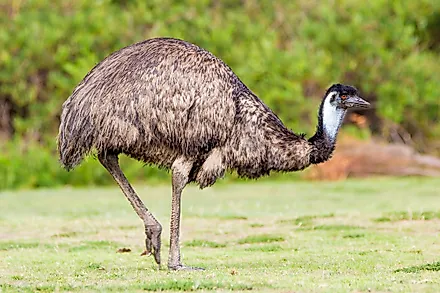
The emu is another animal endemic to Australia. It is the second tallest bird in the world and the largest native bird in Australia. The flightless bird is found throughout most of Australia. Its stable populations and wide range has placed it in the the ICUN conservation category of "least concern" alongside the kangaroo. The emu is an important animal in Australian Aboriginal mythology, included in creation myths and cultural dances. Although flightless, emus have specialized musculature to enable them to run very quickly. They also use their large wings to stabilize themselves while running. The average step is 3.3 ft while walking, but can reach 9 ft at a gallop, reaching almost 50km/h in speed and covering large distances.
National Anthem
- Anthem Title: "Advance Australia Fair"
- Music Composer and Lyricist: Peter Dodds McCormick
- Date of Adoption: April 19, 1984.
The National Anthem of Australia is “Advance Australia Fair”. Scottish-born composer – Peter Dodds McCormick had both composed the music and penned the lyrics in 1878. The National Anthem was officially adopted on April 19, 1984.
“God Save the Queen” which had been the National Anthem from 1788-1974 was designated as the “Royal Anthem” from 1984 onwards; only to be played at events attended by any member of the Royal Family. The National Anthem of Australia is also officially one of the symbols of Australia and hence is treated with respect and dignity. The National Anthem identifies Australia at home and overseas and is used at official public ceremonies, sporting and community events.
Advance Australia Fair
Australians all let us rejoice,
For we are young and free;
We've golden soil and wealth for toil;
Our home is girt by sea;
Our land abounds in nature's gifts
Of beauty rich and rare;
In history's page, let every stage
Advance Australia Fair.
In joyful strains then let us sing,
Advance Australia Fair.
Beneath our radiant Southern Cross
We'll toil with hearts and hands;
To make this Commonwealth of ours
Renowned of all the lands;
For those who've come across the seas
We've boundless plains to share;
With courage let us all combine
To Advance Australia Fair.
In joyful strains then let us sing,
Advance Australia Fair.
The Currency of Australia is the Australian dollar
The Australian Dollar (A$ or AU$) is currently the official currency used in the Commonwealth of Australia which includes Australia, Christmas Island, Keeling Islands, Kiribati, Nauru, and Norfolk Island. The Australian Dollar was first issued on February 14th, 1966 replacing the Australian Pound.
The Australian Dollar is made of subunits known as cents with 1 Australian Dollar being equivalent to 100 cents. It has been the 5th most traded currency in the world behind the US dollar, the Euro, the Yen, and the sterling pound.
Coins and Banknotes
The Australian Dollar is issued by the Reserve Bank of Australia and the currency comes in minted coins and banknotes. The coinage of the Australian Dollar is issued in A$2, A$1, 50 cents, 20 cents, 10 cent, and 5 cent denominations. The banknotes in circulation are comprised of A$100, A$50, A$20, A$10, and A$5 denominations.
Historical Currencies of Australia
The Holey Dollar was the first-ever currency to be struck in Australia, in the then New South Wales colony. The Holey Dollar was essentially a Spanish Dollar with the middle part of the coin being punched out to form two types of coinage – the larger coin with a hole was known as the Holey Dollar and the small coin was called the dump. Due to the alteration of the original Spanish Dollar during the production of the Holey Dollar, the currency was only valuable within New South Wales and was not used anywhere else. A sudden decline in the supply of the Spanish Dollar in the early 19th century caused the Imperial British Empire to reconsider the usage of the Holey Dollar in its New South Wales colony. In 1816, the United Kingdom introduced the gold standard which led the British Empire to adopt the use of sterling coinage in all of its colonies. The Bank of New South Wales was subsequently formed in 1817 and began issuing sterling pound banknotes. Other regions also began minting their distinct currency, with Sydney commencing the minting of sovereigns and half-sovereigns in 1855, Adelaide’s Government Assay Office began the issue of gold pound coins in 1852, and the Government of Queensland issued its distinct banknotes in 1893. In the early 20th century, the Australian Government established policies in line with the adoption of a common national currency. The Australian Pound was adopted in 1910 and was made up of subunits known as shillings, with 20 shillings being equivalent to 1 Australian Pound. The currency was replaced in 1966 by the Australian Dollar.
